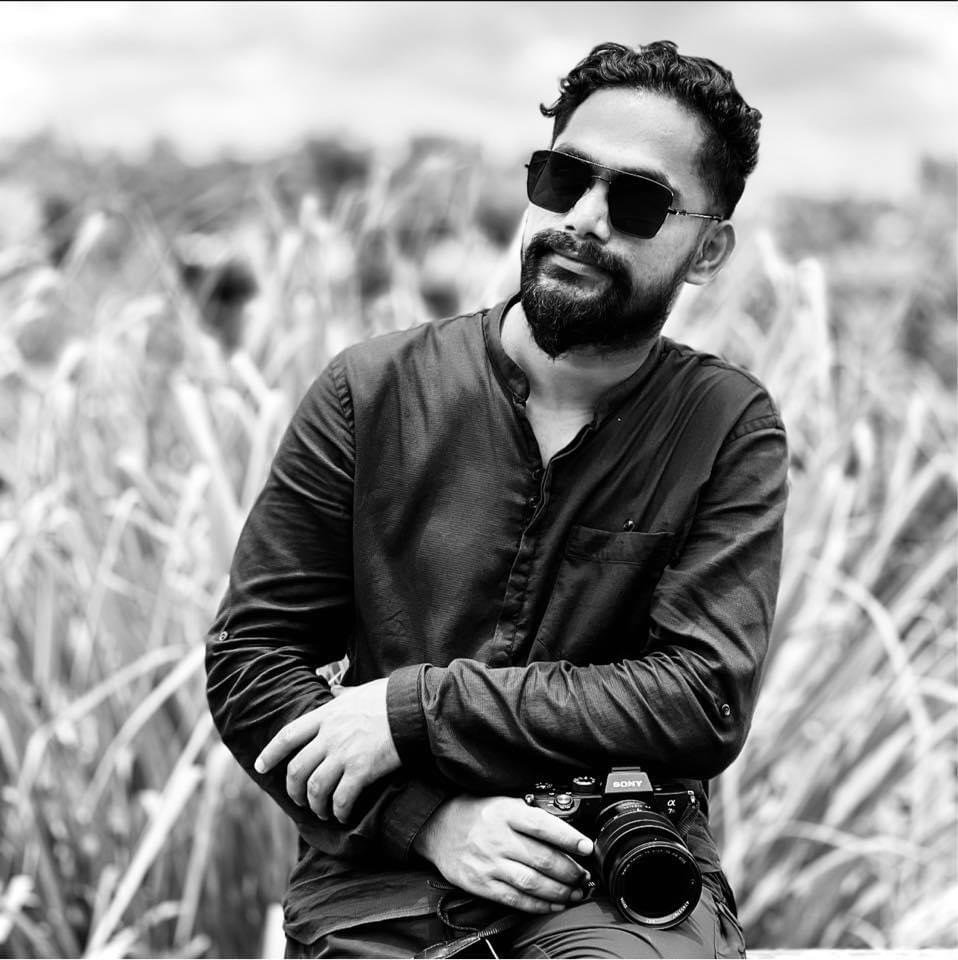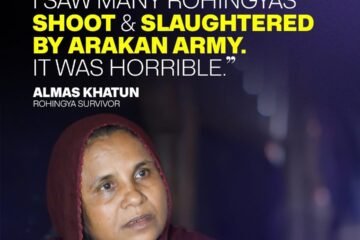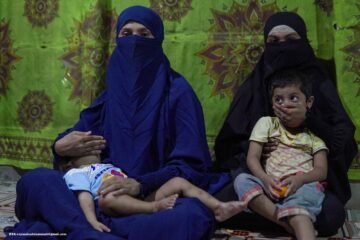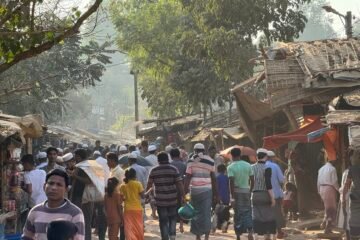Abstract:
This interview with the Rohingya photographer, video maker, and social activist Ro Yassin Abdumonab was conducted by Marcelo Schellini over the monsoon season of 2023. It takes as its point of departure the recent photographic production and related social activities and expe- riences of Rohingya young photographers in Cox’s Bazar, Bangladesh. The interview explores contemporary photographic practices and their role in creating opportunities for self-representation and new forms of socio-cultural engagements and initiatives in the World’s largest refugee camp community. Consequently, by describing the respective digital tools, platforms, and media agencies; this interview reframes the functions of photojournalism and its image of conflicts in the context of the Rohingya refugee crisis.
Keywords:
Photography; Photojournalism; Refugee crisis; Rohingya; South Asia.
The author:
Marcelo Schellini, PhD, is a lecturer at Curtin University, Campus Ma- laysia. His research focuses on photography, visual ethnography, and visual culture studies.
e-mail: marceloschellini@marceloschellini.com
Introduction
Ro Yassin Abdumonab (10.01.1993) is a photographer, video maker, teach- er, and social activist. In 2017, in the wake of the conflict that affected the lives of thousands of Rohingyas in Myanmar, he fled from his native village to settle in the World’s largest refugee camp, Cox’s Bazar in Bangladesh. As a photogra- pher, he has published his work on the Rohingya refugee crisis in many media outlets such as France24, US News, The Guardian, Amnesty International, and Aljazeera, among others. The practice of photography among the Rohingya young generation has become a social phenomenon that can be noticed by the overwhelming number of social media channels and active users all across the internet, as well as by active on-ground social engagements and initia- tives including the periodical publication of Rohingyatographer Magazine. From the heart of the World’s largest refugee camp and amid debates on the credibility of the practices of photojournalism and its image of conflicts, the photographic practice — as experienced by young Rohingya photographers — raises questions about how digital photography has created opportunities for self-representation. It also urges us to reflect on the available digital tools, plat- forms, and agencies promoting its practices; and particularly, to what extent photography catalyzes social change. Although a permanent solution for the Rohingya refugee crisis rests unattained, the Rohingya young photographers’ experience suggests that its photographic practice has been able to produce on-ground social changes: it has fostered new forms of social engagement in the community and has prompted several socio-cultural initiatives creating the professionalization of young media producers and new possibilities for employment in the refugee camps.
Marcelo Schellini (M.S.): How did you start your photographic journey?
Ro Yassin Abdumonab (R.Y.A.): When I arrived for the first time in the refugee camp, I had to work as a fixer and interpreter with international jour- nalists for TV, newspapers, and even researchers. Many photographers and multimedia journalists were taking pictures and making videos of my people. So, I was learning a lot observing them working on photos and videos. Then, I started to take pictures of different kinds of people, their lives, foods, water, and everything related to our lives since the beginning of our influx. Back in those days in my homeland, I was already very interested in taking photos and it was a part of my dreams. Then, I didn’t use my original name on social media for my safety and security. I had to use a pseudonym. Many of the well-known journalists motivated me to be a photographer and I thought that I could do this kind of work for my people as I am living with one million Rohingyas. So, it made it easy to work in this field.
M.S.: Have you been working on photojournalism assignments? How did it start?
R.Y.A.: I worked continuously with many journalists until the end of 2019. At that time there were no assignments for me since journalists had access and permission to enter the refugee camps. When the pandemic Covid-19 started, the lockdown was imposed on all refugee camps as well as on the entire Bang- ladesh people. Then, no journalists were allowed access to refugee camps. I was approached by many journalists to cover the lives of Rohingya during the pan- demic. During the pandemic, I received my first assignment, and since then I have been asked to work for different media taking photos, videos and also writing bylines. That helped me a lot to move forward with my photographic skills. Then there was a huge fire disaster in March of 2021 and I was the first man from the Refugee camp to work on the fire disaster (Fig.1 -2). I was assigned by many news agencies for photos and videos. Many of the international me- dia gave credit to my photos and my work drew the attention of international audiences. Since that time, I was assigned to pitch the stories of Rohingya by local and international news agencies. I have covered the Rohingya crisis such as climate change, fire disasters, monsoon floods, and other general activities in the Rohingya refugee camps. I am at work receiving assignments from NGOs and media agencies. That is the way I am accomplishing my assignments.


Figure 2 Photograph taken in Balukhali refugee camp on March 5th 2023. Ro Yassin Abdumonab©
M.S.: How are you contacted for photojournalism assignments? What is the photographic device you use?
R.Y.A.: I am contacted for photojournalism assignments with the help of recommendations or checking my correspondences through mail or WhatsApp. There are a lot of people for whom I have worked. So, they recom- mend me to others. People like to reach me through social media. Also, there is a strong agreement between us for the needs according to the assignment. I use social media, and many of my works are displayed in my portfolio. Which makes it easy to get contacted through social media. The devices I use for photography are smartphones, cameras, and other tools to take good photos. Most of the time, I carry a smartphone in my pocket because it is easy to take photos in the street or other public places and even in conflict places. When I am assigned to special projects, I use my camera and other tools.
M.S.: Your photos were published in several well-known media outlets such as France24, US News, the Guardian, and Aljazeera among others. Can you make a living with photojournalism as a free-lancing activity? What is the average remuneration for your assignments?
R.Y.A.: Alhamdulillah, I can make a living and support my family with my photojournalism freelancing activity. The average remuneration is around 100/150 USD per day for my assignment. The main thing is that if there are well-known media that like to pay 150/200 per day but if the media is small, then it at least pays 100 USD.
M.S.: You are a member of the Rohingyatographer Magazine pho- tographers. How did it start and what is its purpose and mission? Currently, how many photographer-members do you have?
R.Y.A.: Rohingyatographer Magazine is a platform for Rohingya youth to develop their photography skills and use the medium as a tool for self-ex- pression, community development, and participatory action research (Fig 3). The magazine was created by a collection of talented Rohingya photogra- phers based in Cox’s Bazar, Bangladesh. By aligning with methods such as PhotoVoice, the project aims to raise awareness about the Rohingya commu- nity and their situation, while also providing a historical record of their lives and experiences in the refugee camps. The project has empowered Rohingya youth to tell their stories through photography and to participate in a global dialogue about the issues they face. With media access to the camps becom- ing more restricted after the COVID-19 pandemic, young Rohingya photogra- phers have taken to social media to share their perspectives and experienc- es in their own words (Fig 3). Through their art, they are not only educating themselves but also providing valuable insight into the lives of the Rohingya people for others to learn from. Rohingyatographer Magazine is a unique and essential publication for anyone interested in the Rohingya experience, com- munity-led documentary photography, visual anthropology, human rights, and refugee studies. Currently, there are more than 25 active members in Ro- hingyatographer Magazine and we are trying to add more members who are really qualified. We give them training and instructions to become proficient in photography. Then we request them to work with us collectively. We meet online using Google Meet, Zoom, or WhatsApp calls. Sometimes we meet in person at restaurants or shelters when we have to discuss together to move forward with our activities. Among them, some female photographers take good photos and cooperate with us for magazines and other publications. The female photographers are motivated, talented, passionate, and creative. Their participation in our photographic projects brings gender equality. Sometimes it is better when female photographers are assigned to shoot women’s envi- ronments, especially pictures of women, girls, and other people because they feel comfortable with them.

M.S.: How do you edit Rohingyatographer Magazine and make its printing possible?
R.Y.A.: Every year, we publish two issues with specific themes selected by the photographers. We announced the theme on social media with the submission link to our Google Drive. Submissions are open for every Rohingya Photographer who is interested in contributing. We publish first online and we can print out the copies in Bangladesh only if we get any crowd-funded donations through GoFundMe or grants from organizations.
M.S.: Before photography and its popularization, few people could afford to have their portraits painted on canvas. Do you consider that pho- tography plays an important role in the democratization of portrait and image-making?
R.Y.A.: Yes, I consider that photography plays an important role in the democratization of portraits and image-making because it tells people’s sto- ries. Before photography, it was more difficult to produce visual documents to tell the stories of people due to a lack of access to image-making. Nowadays it has become easy for everyone to keep a visual record and reveal every story through them to the world (Fig 4).

M.S.: I have seen the phenomenon of a large number of young Ro- hingya photographers posting photos daily on several social media. Can you estimate how many Rohingya photographers are active in all of the refugee camps in Bangladesh? What are the most frequently used social media, digital tools, and platforms?
R.Y.A.: In my experience and communication with all Rohingyas across the refugee camps, I find many people, especially youths who like to take pictures of different activities inside the camp and post them on social media writing about raising voices for refugees. But most of them don’t do it profes- sionally. There are a few Rohingyas who are professionals whose photos are widely published globally. In my estimation, the professional photographers are just 10 or 12 in the whole community, and they all became professionals during their stay in Cox’s Bazar. The most frequently used social media are Facebook, Instagram, and Twitter for posting pictures on the web. Some also used editors for photos and videos such as Lightroom and Snapseed to make them look professional. Many youths are seeking to become professional pho- tographers in camps but most of them don’t get the opportunity to sell their works. It is important to recognize their works but unfortunately, their pictures are not used globally. Once their photographs get published by international agencies like Reuters, they will be motivated and encouraged to pursue their career as a photographer in the future.
M.S.: How did you take this photo? How did it come to be published in France24/The Observers? Could you tell us a little about the “behind the scenes” of publishing it?
R.Y.A.: I took this photo by standing at the top of the hill with my smart- phone because the whole low ground was flooded with torrential downpours for some days (Fig 5). I couldn’t carry all my instruments in the heavy rain. There were thousands of shelters including learning centers, mosques, and other offices engulfed by flood. As a consequence, many people were rendered homeless. They lacked food and clean water and suffered from unavailability of healthcare at that time. I was on assignment for the NRC (The Norwegian Refugee Council) to cover monsoon floods and landslides that badly impacted refugees’ lives. So France24/Observers reached me for photos of the disaster in the camp. I thought it was the best opportunity for me to publish this photo through that great website. That would demonstrate a lot of Rohingya suffer- ing to the world.

M.S.: Has the Rohingya conflict been given enough coverage in the mainstream media?
R.Y.A.: I think the Rohingya conflict hasn’t been given enough coverage in the mainstream media because if they had covered the crisis of Rohingya enough to highlight everything, then it wouldn’t have taken much time to solve the crisis. It has been more than 6 years that displaced Rohingyas have been taking refuge in Bangladesh with so many challenges but nothing has changed yet. It is time to take the step of moving forward to solve the Rohing- ya crisis. Now I think it is a serious matter for me if I don’t raise my voice for myself and my people
M.S.: During the 1960s and 70s — specifically during the US-Vietnam conflict — photojournalism reached its maximum capacity to induce social change. Unveiling the conflict’s atrocities to a large audience, photogra- phers were able to influence the public sphere to put a definitive end to the war. At that time, the ‘golden age’ of photojournalism, enough magazines and newspapers were willing to publish photographs, but during the 1980s television took over as the primary source of hard news (Badger 2007:76). Does photojournalism still have the same potential for social change?
R.Y.A.: Yes, I believe that photography still has the power and potential for social change nowadays. Photojournalism is a voice for the voiceless people and it brings peace and justice to marginalized communities. For example,
through my photojournalism work, I believe that I am bringing changes in the community and possibly bringing positive results for the people.
M.S.: However, the US-Vietnam conflict impacting images still couldn’t prevent the outbreak of other wars like those of Iraq, Afghanistan, Syria, Ukraine, and Palestine. What could have failed?
R.Y.A.: It is difficult to answer this question because it is related to global issues. In short, there is a gap between information and certain political agen- das that manipulate the true narrative and misinform international audiences not to believe them.
M.S.: Even if we assume that presently photojournalism is not en- tirely effective in inducing social change through the audience’s recep- tion, the Rohingya photographic experience in Cox’s Bazar suggests that its practice has socially engaged a large number of young pho- tographers around the idea of disclosing the Rohingya refugee crisis to the world. This experience has fostered new forms of social engagement in the community and has prompted many socio-cultural initiatives like the photographers’ collective and the magazine of which you are a member. What kind of positive changes and results does it produce on- ground for the community? How has the photographic practice trans- formed the Rohingya community?
R.Y.A.: Rohingya people can tell their own stories through their eyes to the world. This can help the international community to be aware of the crisis and bring positive hope to vulnerable people. I think the Photographic practice has transformed the Rohingya community politically, professionally, and eth- ically in their lives. Because most Rohingyas had hope in Myanmar to use pho- tojournalism to tell the stories of their people to the world. But they couldn’t do it as there were restrictions for Rohingyas to access this kind of activities. But now in the community, most of the Rohingyas like to tell the stories via photos. I think there is a huge transformation in this trend. For example, there are offline and online classes and workshops that help the community to learn many things about photojournalism and its ethics to do it professionally. Also, there are so many professional activities, photo organizations, associations, photo exhibitions, magazine releases, and websites that make them obtain photography skills to keep working on it more and more. Most of them are motivated and self-confident, improving in doing the good things for the peo- ple. Most Rohingyas think that they can raise their voices through the lens to bring changes among themselves, they hope for better lives with facilities and opportunities.
M.S.: Photojournalism has been criticized for representing surfaces of suffering rather than its causes (Stallabrass, Julián et al. 2022: 197). How would you represent the causes of a conflict? How would you represent the causes of the Rohingya refugee crisis?
R.Y.A.: The Rohingya refugee crisis is a consequence of discrimination, racism, persecution, oppression, extrajudicial killings, and massacres perpe- trated by Myanmar’s brutal government over more than 70 years. Whereby it has snatched our citizenships and denied our motherland. There are more than 126 ethnic groups, including Rohingya, in Myanmar. Except for Rohing- yas, all of them receive the same human rights, freedom of movement, and religion. It is all based on religious discrimination since the Rohingyas are the sole Muslims in the country. Rohingyas are the bona fide and indigenous cit- izens of Myanmar. I attempt to represent the causes of conflict as a demand for our rights which has been denied and is the very source of the conflict. The international community should consider this issue and try to solve the conflict so Rohingyas can get back to their own country with rights, safety, and security.

M.S.: Since the beginning of Photography, the photographic medium has been used as a witness of world events, but how to ensure its authentic- ity and faithfulness in the representation of reality?
R.Y.A.: In my work, I do feel responsible for the authenticity of the image. I try to ensure the authenticity of the displacement of thousands of Rohingya who see no hope of making a living in congested camps. I make an effort to ensure the authenticity and faithful representation of reality by the portrayal of situations that matter in the life of the community. Rohingya people have a rich culture, traditions, and language that are the community’s real face, a manifestation of these people. Photography is a means for telling the visual stories of people, to describe their lives in detail.
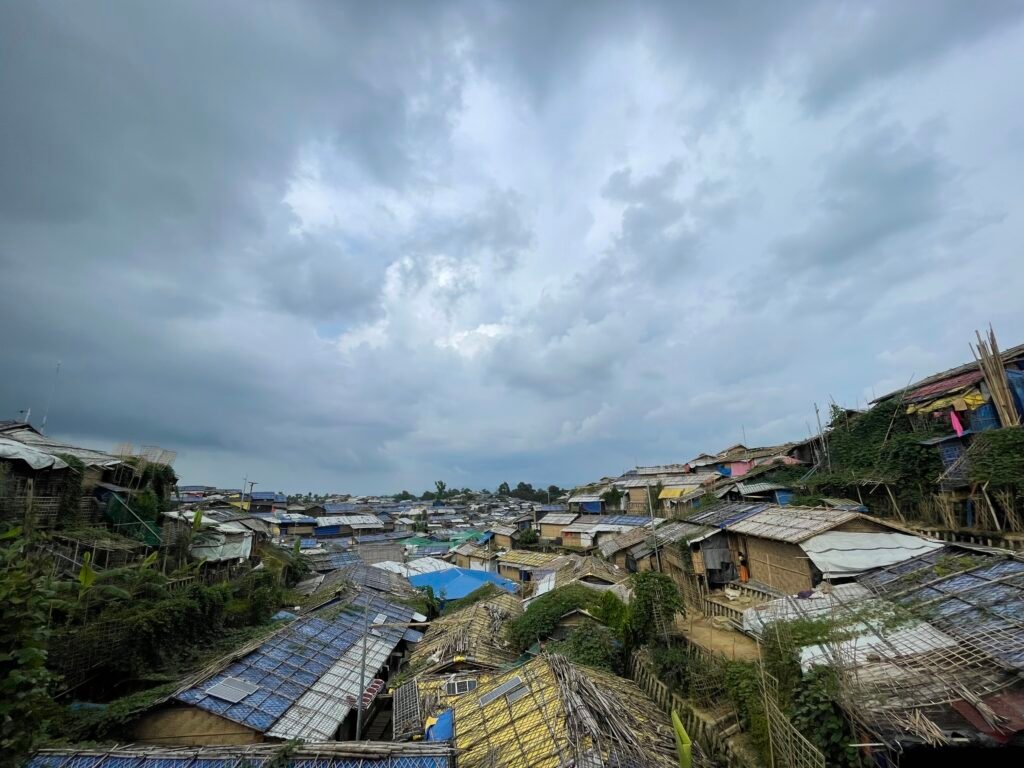
M.S.: Do you teach photography? Why is Photography important to be taught?
R.Y.A.: Yes, I teach photography to many youths including females in the camp because most of the youths are so interested in photography. They are confident that they can tell the story of Rohingyas through their lenses. Photography is important to be taught because a picture can tell thousands of words and if an image is captured well it tells stories although there is no caption. The refugee crisis is a long-term issue for Rohingyas and the interna- tional community. So, it needs to be told again and again via photos. The world cannot forget us.
M.S.: Is there anything else you want to say, perhaps a message to young photographers at Cox’s Bazar refugee camps and all over the world? R.Y.A.: My message to young photographers in Cox’s Bazar refugee camps and others across the world is to make the best photos no matter what devices you use. To tell the stories, you don’t need a very high-quality device for making the best photos. You can make the best pictures to tell the stories through a cellphone or a camera. What you need is your effort to make the best pictures through your ideas and imagination. Telling the people’s stories is what makes me happy.
Original Publication : http://www.vejournal.org/index.php/vejournal/article/view/327
References
Badger, Gerry
2007 Mission Impossible? 60 Years of Magnum. Aperture Archive. 187 (3)
68–83. https://issues.aperture.org/article/2007/2/2/mission-impossible
Stallabrass, Julián – Alex Fletcher – Andrew Fisher
2022 Killing for Show: Interview with Julian Stallabrass. Philosophy of Photo-
graphy, 13 (2) 183-205. DOI: 10.1386/pop_00057_2
